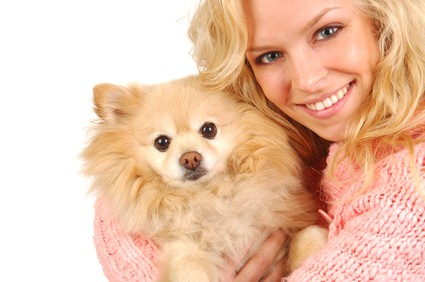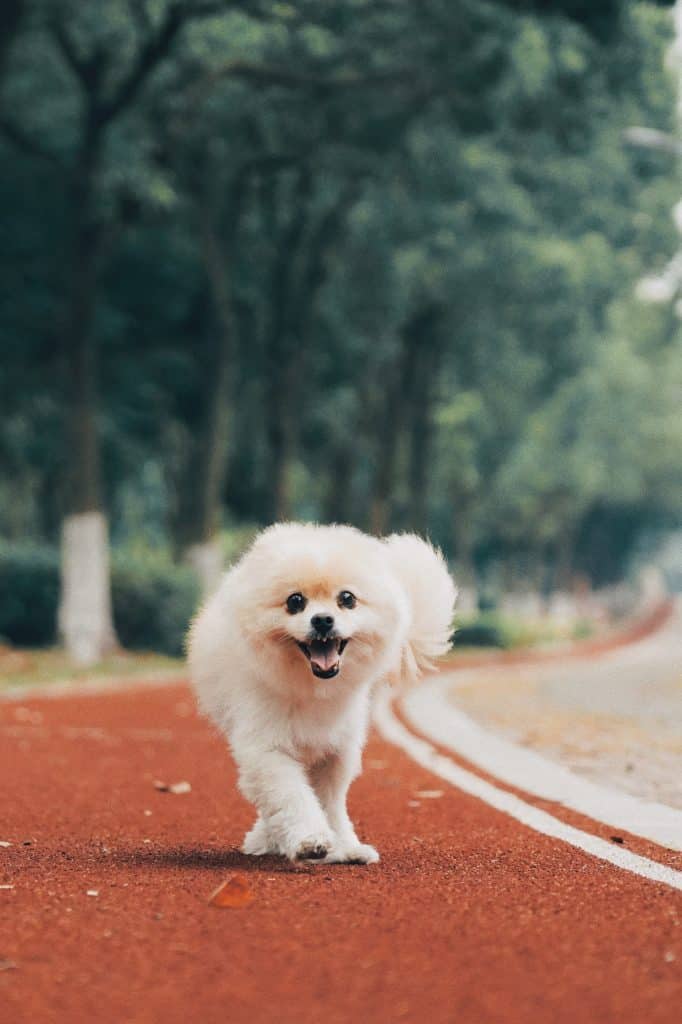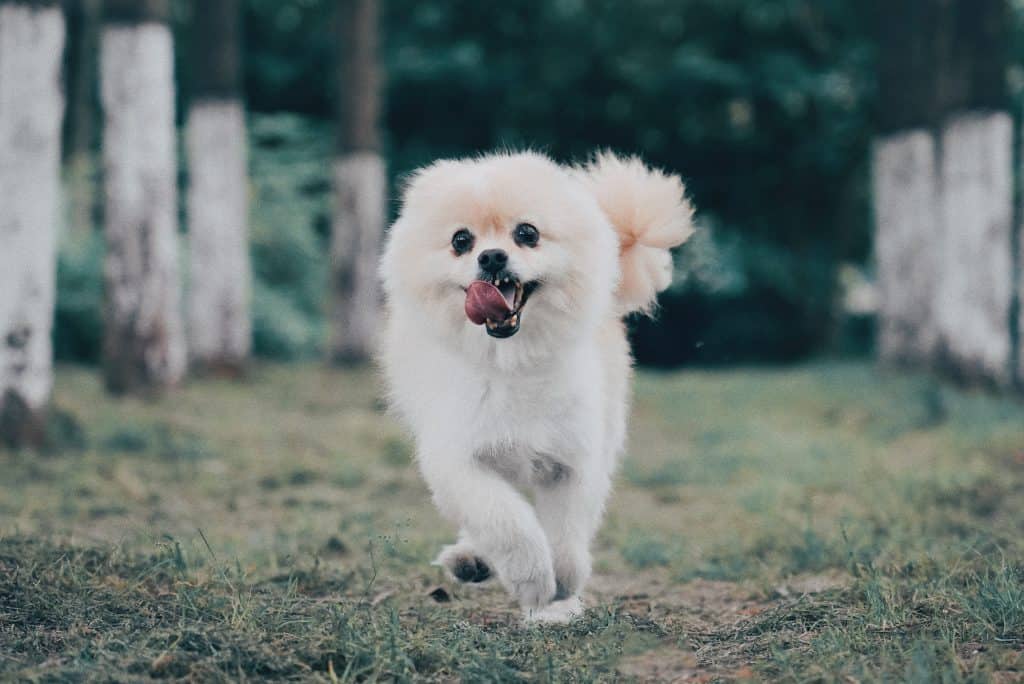There are few dogs that are as cute as these little lion-like dogs with their teddy bear eyes, but does the Pomeranian temperament match his sweet exterior?
These toy breed dogs, also known as Pom Poms, originated in Germany as a favorite lap dog of the royal court and most Poms still act like a member of the royal class.
Here are the top 7 Pomeranian traits you need to know about the Pomeranian temperament before
1. Pomeranians love their humans with all their hearts!
One of the things about the friendly Pomeranian temperament that makes them such popular dogs is that they are very affectionate and loyal.
They want to be with you all the time and this can be both a good and bad thing.
Many Poms suffer from Separation Anxiety if they do not understand their role in the family.
The best way to avoid anxiety related behavior problems is by providing lots of physical exercise and by setting yourself up as the clear pack leader.
Click Here to learn about the benefits of daily exercises for your Pomeranian.
You can prevent separation anxiety by training your Pom from a young age to accept your absence.
For
Leave the room for a few seconds. When you return, remove the coveted treat and put it away. Your Pom should only get its special treat when you leave the room.
Pretty soon, your Pom will look forward to you leaving for work every day! You can also try crate training your Pomeranian to give him a safe space when you are away.

Another great option is to bring your Pomeranian to a doggie daycare center while you are at work.
Your Pomeranian will get to romp and play with canine friends all day, and you will pick up a very tired pooch at the end of the day!
If your Pomeranian suffers from severe separation anxiety, work with a professional positive-reinforcement trainer and your veterinarian.
2. Pomeranians get along with just about everyone.
One of the nice things about the sociable Pomeranian temperament is that these little guys get along so well with each other as well as other animals.
They tend to be very active, happy little dogs that enjoy playing and cuddling. The one exception to this is young children.
Pomeranians are tiny and delicate. Their fragile bones can break with rough handling. They are not the right choice for a family with young children.
Pomeranians can be defensive if they feel threatened. They will growl and nip when they are frightened.
For the safety of the dog, as well as the children, consider another breed if you have small kids.
Pomeranians are better suited to households with adults and/or older, gentle children.
It is important to socialize your Pom from a young age with as many people as possible.
This will help them grow up to be confident, friendly adult dogs. Enroll in a puppy socialization class if possible.
Do not coddle your Pom or shield him from the world by carrying him in your purse. This will make him fearful of new situations.
Instead, use treats to teach him that new people and places are fun and positive! This will help him develop that extroverted Pomeranian temperament that we know and love!
3. Pomeranians are confident, brave little dogs.

Despite being only 7-12 inches tall, the Pomeranian is a very bold and brave little dog. This makes them a lot of fun to interact with but can also lead to “Small Dog Syndrome.”
With small dogs, we tend to allow a lot of ill-mannered behavior that we would never allow in a larger dog.
This leads little dogs like Pomeranians to believe that they rule the roost and can get away with anything they want.
As a responsible Pom owner, you will want to establish rules and boundaries that will help avoid Small Dog Syndrome.
Use treats to reward good behavior that you want to encourage. Use “time outs” to correct bad behavior that you would like to extinguish.
Pomeranian Barking
One of the most common behavior challenges is Pomeranian barking. Barking is usually an attention-seeking behavior.
Pomeranians bark to demand attention, food or treats from their owner.
Instead of giving in, ignore your Pomeranian’s barking. Your Pom will learn that barking gets him nothing, and over time that behavior will decrease.
It takes patience and consistency. If one person in the family gives in and gives the dog attention when he is barking that will undo weeks of training
It will take time, but you can improve barking behavior.
However, at the end of the day, Pomeranians are simply vocal dogs.
So if you cannot tolerate a little barking, the Pomeranian is probably not the breed for you.
Likewise, if you live in an apartment and your neighbors are sensitive to noise, a Pomeranian might not be the best choice for your lifestyle.
4. They make great pint-sized watchdogs!

It may seem crazy to think about a 3-7 pound bundle of fluff as a watch dog, but it’s true.
The confidant Pomeranian temperament and their tendency toward territoriality mean that they will always let you know when a stranger is up to no good.
It is important that these little tough guys be socialized at a young age.
Pomeranians need to be exposed to lots of people as well as unusual sights and loud sounds so that their naturally cautious nature does not turn into suspiciousness.
A suspicious dog can lead to a defensive dog if not properly socialized.
5. Pomeranians are smart and love to learn.
Because of their agility and eagerness to learn, Poms have been used as circus dogs as well as in Hollywood.
It does, however, take a consistent and patient person to bring out their best.
Their intelligence has made them one of the few toy breeds that compete and excel in agility competition.
The active Pomeranian temperament makes this breed a great competitor within the world of canine sports!
As with all smart dogs, you have to make sure that your cute little fluff-ball doesn’t outsmart you!
6. They crave attention.

While Pomeranians don’t require a lot from their owners in terms of food and exercise (they will run around the house if they need
The Pomeranian temperament is a mix between independent and loyal but they love nothing more than to sit on your lap and be showered with love and affection.
The good news is that they will give it right back and nothing can brighten your day more than having those adorable eyes turned on you with adoration.
7. Poms are active and alert.

It isn’t uncommon to see a Pomeranian trotting around the house, exploring everything with his sharp little nose.
Because of the bold Pomeranian temperament, they are often brave enough to be inquisitive about new places and people.
Pomeranians are active! Even though they are small, they need daily exercises.
The playful Pomeranian temperament makes this breed a fun choice for people who enjoy lots of
Pomeranian Origins and History
Pomeranians descend from large, spitz-like sled dogs.
The Pomeranian's origin is Germany, but England also played a key role in this breed's development.
To some the Pomeranian also goes by names such as the Loulou and Dwarf Spitz.
Their name comes from a region of northeastern Europe that used to be called “Pomerania.”
The breed became popular thanks to Queen Victoria, who was a huge collector of Pomeranian dogs.
Pomeranian Colors and Physical Characteristics

Pomeranians are tiny and adorable. They look like stuffed animals.
The Pomeranian weight can be anywhere between 3 lbs and 7 lbs.
Pomeranian size is between 6-7 inches. You can use a Pomeranian growth chart to estimate how big your puppy will be.
Poms have perky ears, an alert expression and a tightly curled tail.
Pomeranian colors vary widely. All colors and patterns are accepted by the American Kennel Club breed standard.
The red Pomeranian and the black Pomeranian are the two most prevalent color varieties.
The orange Pomeranian is a slightly lighter color variety.
The grey Pomeranian, white Pomeranian, and orange sable Pomeranian are rare.
Pomeranian Training
Pomeranians are clever little dogs. They are intelligent and trainable. Always use force-free, positive reinforcement methods to train this breed.

Positive reinforcement is the most effective and humane method of training. Never use harsh punishments during training.
Pomeranians can learn lots of cute tricks! However, one area that can be difficult is potty training.
Like all tiny dogs, Pomeranians have tiny bladders. They cannot “hold it” as long as larger dogs.
If you work long hours, you may need to install a doggie door or put down pee pads for your Pom.
You could also hire a dog walker to take your Pomeranian out in the middle of the day.
Helpful Dog Training Resource:
For help with training your dog, you should take a look at The Online Dog Trainer by Doggy Dan. Doggy Dan is an expert Dog Trainer based in New Zealand. His online resource contains Hundreds of Excellent Dog Training Videos that will take you step-by-step through the process of developing a healthy, happy well-behaved dog.
Pomeranian Grooming
Pomeranians have thick, double-coats. Therefore, they require a lot of brushing and grooming.
Make sure you take this into account before you adopt a Pomeranian. You may even have to learn how to do a Pomeranian haircut!
If you are not able to groom your Pom yourself, you will need to bring your Pom to a professional groomer every few weeks.

Professional grooming can get pricey. However, it is very important to prevent your Pom from getting matted.
It is also important to trim the hair around the sanitary region on a regular basis for cleanliness.
And since we mentioned haircuts, whether you do it yourself or go to a groom there are countless Pomeranian cuts and Pomeranian hairstyles
If you want to keep your dog’s coat short, a shaved Pomeranian is actually not recommended.
Instead, ask your groomer about a Pomeranian lion cut, Pomeranian fox cut, or other Pomeranian short haircuts.
Pomeranian shedding is moderate during most of the year and heavy during shedding seasons.
Pomeranians are not considered hypoallergenic, so they are not ideal for owners with allergies.
Health Concerns
Pomeranians are predisposed to many of the same health concerns as you would find in other small breeds.
- Luxating Patellas – This is a condition which causes the knee-cap to slip out of place and is the most common health concern with Pomeranians.
- Collapsing Tracheas – Because of their fragility, it is important that a harness as opposed to a collar be used when leading a small dog like a Pom. Even a gentle tug on a leash attached to the collar of such a small animal can cause damage to their trachea.
- Bad Teeth – With a good diet which includes crunchy kibble, you can deter many of the dental issues of which Pomeranians are prone. Also, you will want to have your little one’s teeth cleaned on a regular basis by your vet.
Like all dogs, your Pomeranian should visit the vet every year for a checkup and vaccinations. Your Pomeranian should be on flea and heartworm prevention at all times.
If you notice any
Spaying and neutering
With good care, the Pomeranian life expectancy is 12-16 years.
Helpful Dog Health Resource:
Note: Our Health is #1 Priority. It should be no different for your dog. But you need to help him. The Ultimate Guide to Dog Health is the answer. This handy guide will help you recognize the symptoms of the health problems above. Get the knowledge to stay ahead of these terrible issues that can rob your lovely dog from vigor and life. Help your friend make it to 14 yrs+ without pain and suffering.
Pomeranian Adoption and Rescue
If you would like to add a Pomeranian to your household, please check out Pomeranian rescue groups, animal shelters, and adoption agencies before going to a breeder.
There are actually many Pomeranians out there looking for homes!
A great place to start is your local animal shelter or humane society. If there are no Poms available on the day that you visit, ask to leave an application on file for the future.
If you are open to Pomeranian mixed breeds, you may find a match even sooner!
You can also search for adoptable Pomeranians online through websites such as Petfinder.com, Adoptapet.com,
Facebook is another great resource for pet adoption. You can search for Pomeranian rescue groups in your region.
The adoption fee for a Pom from a rescue group or animal shelter will probably be between $75 and $200. Most dogs from rescue groups and shelters will be vaccinated, microchipped, spayed/neutered and vetted prior to adoption.
Finding Pomeranian Puppies for Sale

If you decide to work with a breeder, do your research to find reputable Pomeranian breeders.
A good place to start is the American Pomeranian Club, Inc.
Once you identify a Pomeranian for sale, ask to visit the breeder in person and tour the premises.
A good Pomeranian breeder will welcome your visit. They will want to meet you in person and ask you questions, too. If your breeder does not want you to visit, this is a red flag.
Never purchase a Pomeranian puppy for sale through a website or a pet store. Always visit the breeder in person.
Pomeranian puppies are cute and puppy mills can sell them easily for a profit. Make sure you do not fall into this trap!
Also, Just because a Pomeranian puppy has AKC papers does not mean that it came from a reputable source.
The Pomeranian price from a quality breeder varies widely. It might be as low as $500 or as high as $4,000.
Checkout our Complete Guide to Breeders:
We wrote the definitive guide on finding, selecting, and dealing with dog breeders. This will give you the smarts and confidence to save you money, time and heartache. Read On…
Is the Pomeranian the right dog breed for you?
If you are looking for a small dog with a big attitude and will enjoy the Pomeranian’s temperament which is both independent but loyal and loving, then this might be just the right little dog to bring into your family.

Calvin is the co-founder and one of the main contributors to dogtemperament.com. He has been an avid dog lover all his life. He enjoys researching and sharing great ideas on how you can avoid common pitfalls of dog ownership and build the most loving and enjoyable relationship with your dog.
